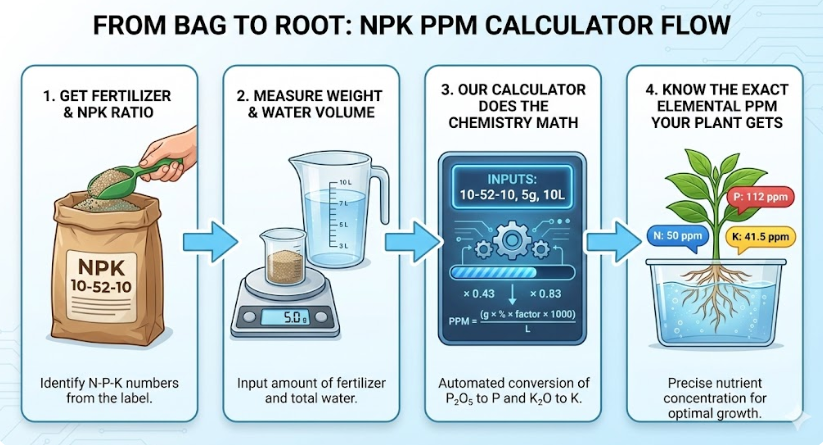NPK PPM Calculator
Convert fertilizer N–P₂O₅–K₂O analysis to elemental PPM for nutrient monitoring.
1️⃣ Fertilizer Composition (from label)
2️⃣ Application Details
Nitrogen (N)
0
Phosphorus (P)
0
Potassium (K)
0
P = P₂O₅ × 0.436 | K = K₂O × 0.830
PPM = (grams of element ÷ liters of water) × 1000
Example: 5 g of 20–20–20 fertilizer in 10 L water → ≈ 100 PPM N, 44 PPM P, 83 PPM K.
Hydroponic NPK PPM Calculator – Accurate Nutrient Solution Mixing Tool
Mix nutrient solutions with precision. Calculate NPK values in PPM from fertilizer percentages and grams per liter. Ideal for hydroponics, greenhouse growers, and plant nutrition control.
An NPK PPM Calculator is an essential tool for gardeners and hydroponic growers, helping them determine the precise nutrient concentration in their fertilizer solution. PPM stands for “parts-per-million,” a critical measurement that quantifies the amount of Nitrogen (N), Phosphorus (P), and Potassium (K) available to plants.
This calculator solves the common problem of mixing fertilizers correctly, ensuring plants receive the right nutrients without the risk of over- or underfeeding. It’s the go-to resource for anyone asking, “How do I mix my fertilizer for the best results?” or “What’s the right nutrient concentration for my plants?”
How to Use an NPK PPM Calculator
Using a calculator to determine your nutrient levels is straightforward and empowers you to make data-driven decisions for your plants’ health. Here’s what you need to know:
- NPK Ratio: This refers to the three numbers prominently displayed on a fertilizer bag, such as 20-20-20 or 10-5-15. They represent the percentage by weight of Nitrogen (N), Phosphorus (P2O5), and Potassium (K2O) in the product.
- Fertilizer Amount: This is the quantity of fertilizer you plan to use, measured in grams, teaspoons, or tablespoons.
- Water Volume: This is the total amount of water you will be mixing the fertilizer into, typically measured in gallons or liters.
The calculator takes these inputs and, using standard conversion factors, quickly computes the ppm for each of the three macronutrients. This immediate feedback helps you adjust your recipe for optimal plant growth.

Why is Calculating NPK PPM So Important?
Accurate nutrient measurement is a cornerstone of successful plant cultivation, particularly in hydroponic systems and container gardening where plants depend entirely on you for nutrition.
- Prevents Nutrient Burn: Over-fertilizing, or “nutrient burn,” can damage roots and leaves, stunting growth and potentially killing your plants. Knowing the exact ppm helps you stay within a safe range. For example, many leafy greens thrive in a ppm range of 800-1200, and a calculator helps you hit that target precisely.
- Optimizes Growth: Different growth stages, like vegetative and flowering, require different NPK ratios. A calculator allows you to tailor your solution to meet these changing needs, promoting vigorous growth and abundant yields.
- Saves Money: By preventing the overuse of expensive fertilizers, you can maximize your resources and reduce waste. Getting the mix right the first time eliminates the need to discard and remix batches.
Example Use Case: Feeding Tomato Plants
Imagine you’re growing tomatoes and want to create a nutrient solution with a high potassium ratio to encourage fruiting. You have a fertilizer with an NPK of 4-18-38. You want to know if mixing 1 tablespoon of this fertilizer into 1 gallon of water will give you the desired PPM.
Instead of guessing, you can simply plug these numbers into a calculator to get an exact ppm for each nutrient, ensuring your tomatoes get the perfect balance for a bountiful harvest.
